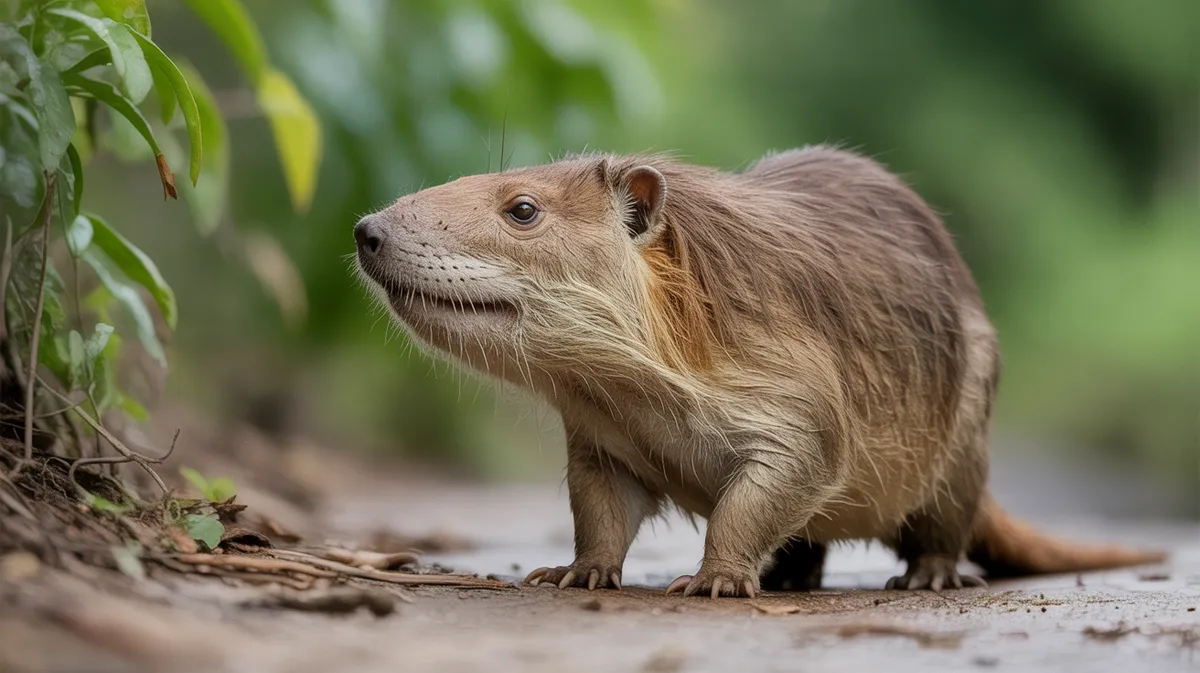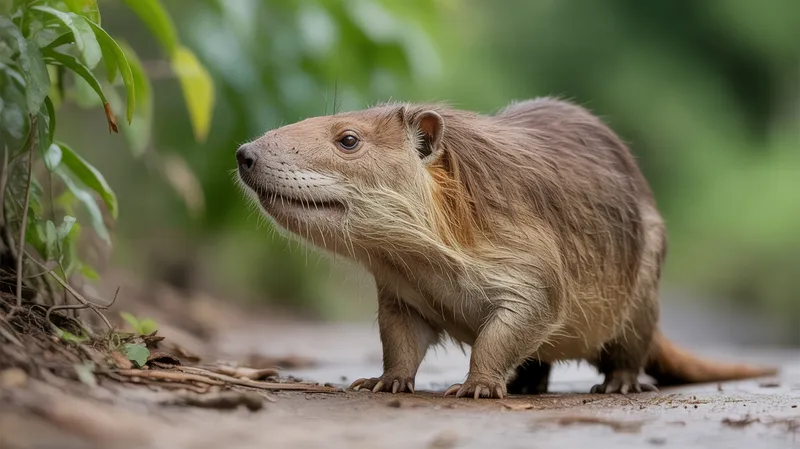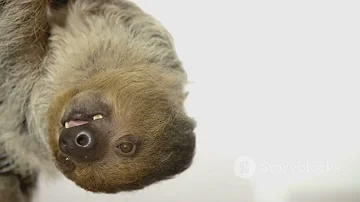
Hispaniolan Solenodon
Solenodon paradoxus

Meet the Hispaniolan Solenodon
The Hispaniolan solenodon is a rare, nocturnal mammal native to the island of Hispaniola in the Caribbean. It has a long, flexible snout, small eyes, and a body resembling a large shrew, covered in coarse fur. Notably, it is one of the very few venomous mammals, delivering toxic saliva through grooves in its lower incisors. Solenodons are primarily insectivorous and play a vital role in their ecosystem by controlling insect populations. Due to habitat loss and introduced predators, this ancient mammal is now classified as endangered.
Classification
Mammal
Habitat
Moist forests and brushy areas of Hispaniola
Diet
Omnivore
Lifespan
5–11 years
Conservation
Endangered
Weight
0.6–1 kg
📖Fascinating Facts
Venomous Bite
The Hispaniolan solenodon delivers venomous saliva to its prey through specialized grooves in its lower incisors, a rare trait among mammals.
Nocturnal Lifestyle
Solenodons are strictly nocturnal, foraging for insects, spiders, and small animals under the cover of darkness.
Ancient Lineage
Solenodons are considered 'living fossils' because their evolutionary lineage dates back over 76 million years.
📋Detailed Description
The Hispaniolan solenodon (Solenodon paradoxus) is a medium-sized, nocturnal insectivore with a body length of 28–33 cm (11–13 in) and a tail measuring 17–26 cm (6.7–10.2 in). Adults typically weigh between 0.6 and 1 kg (1.3–2.2 lbs). Its most distinctive feature is an elongated, highly flexible snout, supported by a unique ball-and-socket joint at the base, allowing for precise probing of leaf litter and soil. The fur is coarse, ranging from dark brown to reddish-brown, with a paler underside and a naked, scaly tail. The eyes are small and adapted for low-light vision, while the ears are relatively short and rounded. Its limbs are robust, with strong claws on the forefeet for digging. The dentition is primitive, and the lower second incisors are grooved to deliver venomous saliva—an extremely rare trait among mammals. The solenodon’s gait is somewhat awkward, often described as shuffling or waddling, and it is capable of rapid, erratic bursts of movement when threatened. Solenodons are solitary and secretive, spending daylight hours in self-dug burrows or natural crevices. Their senses of smell and hearing are highly developed, compensating for poor eyesight. This species is considered a living fossil, retaining many ancestral characteristics from early placental mammals of the late Cretaceous.
💡 Did you know?
The solenodon’s closest relatives went extinct millions of years ago, making it a living fossil.
🔬Research & Sources
Wikipedia Summary
The Hispaniolan solenodon, also known as the agouta, is a small, furry, shrew-like mammal endemic to the Caribbean island of Hispaniola. Like other solenodons, it is a venomous, insect-eating animal that lives in burrows and is active at night. It is an elusive animal and was only first described in 1833; its numbers are stable in protected forests but it remains the focus of conservation efforts.
Last Modified: 5/25/2025
🎭Behavior & Social Structure
Hispaniolan solenodons are strictly nocturnal, emerging from their burrows shortly after dusk to forage. They exhibit solitary behavior, with individuals maintaining overlapping but largely exclusive home ranges. Foraging involves methodical probing of the ground with their sensitive snout, using their foreclaws to dig for insects, earthworms, and other invertebrates. Their diet is supplemented with small vertebrates, fruits, and occasionally plant matter. Solenodons use echolocation-like clicking sounds for navigation in the dark, and communicate with a repertoire of vocalizations including squeaks, grunts, and hisses. When threatened, they may freeze, emit high-pitched distress calls, or attempt to flee in a zigzag pattern. Social interactions are rare outside of the breeding season, though mothers are highly attentive to their young. Scent marking is believed to play a role in territory delineation.
👶Reproduction & Life Cycle
Breeding in the Hispaniolan solenodon is not strictly seasonal, though peaks may occur during the wet season when food is abundant. Females typically give birth to one or two litters per year, with each litter consisting of 1–3 young (most commonly two). The gestation period is estimated at 84–90 days. Newborns are altricial—blind, hairless, and weighing only a few grams. Uniquely, the mother possesses only two functional teats, located near her rear legs, which limits litter size. The young cling to the mother’s teats and are carried in tow for several weeks. Weaning occurs at around 2–3 months, but juveniles may remain with the mother for up to six months before dispersing. Parental care is exclusively maternal; males do not participate in rearing.
🛡️Adaptations & Survival
The Hispaniolan solenodon’s most remarkable adaptation is its venomous bite, delivered via specialized grooves in the lower incisors—an ancient trait shared only with the closely related Cuban solenodon. This venom incapacitates prey and may deter predators. Its flexible snout, supported by a ball-and-socket joint, allows for precise manipulation of food and exploration of narrow crevices. The robust forelimbs and claws are adapted for digging and unearthing subterranean prey. Solenodons have a low metabolic rate and can survive on a varied diet, an advantage in fluctuating environments. Their nocturnal and subterranean habits reduce predation risk and competition. The retention of primitive skeletal and dental features reflects their ancient evolutionary lineage, making them valuable for studies of mammalian evolution.
📚Research Sources
🎨Cultural Significance
The solenodon is little known in local folklore, partly due to its elusive habits and nocturnal lifestyle. In some rural communities, it is regarded with curiosity or superstition, occasionally believed to possess magical or medicinal properties, though there is little evidence of systematic use in traditional medicine. The species has become a symbol of Hispaniola’s unique biodiversity and is increasingly recognized as a flagship species for conservation efforts on the island. Its status as a 'living fossil' has attracted scientific and ecotourism interest, raising its profile in conservation campaigns.
🔬Recent Research & Discoveries
Recent genetic studies have confirmed the solenodon’s ancient lineage, diverging from other placental mammals over 76 million years ago, making it one of the most evolutionarily distinct mammals alive today. Ongoing research includes radio-tracking to study home range and movement patterns, venom composition analysis, and population genetics to assess genetic diversity and connectivity between populations. Conservation genetics projects are underway to inform management strategies. Notably, the solenodon’s genome has been sequenced, providing insights into mammalian evolution and the genetic basis of venom production. Field studies remain challenging due to the animal’s secretive habits and low population densities.
🎥Wildlife Videos

25 fascinating facts about the enigmatic Hispaniolan Solenodon
Welcome to our channel, where we reveal 25 fascinating facts about the enigmatic Hispaniolan Solenodon! Join us on this ...
Intriguing Facts and Motivation

Exploring Haiti’s Highlands: Discover the Unique Wildlife of the Massif de la Hotte #cuteanimal
Exploring Haiti's Highlands: Discover the Unique Wildlife of the Massif de la Hotte Venture into the breathtaking landscapes of ...
CuteAnimal_JC

How The Solenodon Became Venomous
The venomous mammal club is so small you'd think they'd all be closely related, but it turns out solenodons have been doing their ...
Bizarre Beasts

Meet the Solenodon: The Venomous, Ancient Mammal of the Jungle!
Discover the Solenodon, one of the most fascinating and ancient creatures lurking in the jungle! Despite its rat-like appearance, ...
Beyond the Senses

The Hispaniolan Solenodon is considered a living fossil
Please enjoy watching, Like, Comment, Share and Subscribe.
Elsie Duvenage

The Solenodon: A Living Fossil of the Caribbean | WildFlixx
Join us on an extraordinary journey into the hidden world of the Solenodon, a rare and enigmatic creature that has captured the ...
WildFlixx
🌍Habitat Information
The Hispaniolan Solenodon typically inhabits Moist forests and brushy areas of Hispaniola environments. Hispaniolan Solenodons have adapted to their environments with specialized features and behaviors.
Primary Habitat:
Moist forests and brushy areas of Hispaniola
More detailed habitat information will be available soon.
🛡️Conservation Status
The Hispaniolan Solenodon is currently classified as Endangered. Conservation efforts are crucial for preserving this species for future generations.
Common Threats:
- 🏠Habitat loss and fragmentation
- 🌡️Climate change impacts
- 🎯Hunting and poaching
- 🏭Human-wildlife conflict
⚠️Threats & Conservation Challenges
Major threats to the Hispaniolan solenodon include habitat loss due to deforestation, agricultural expansion, and human settlement. Introduced predators, particularly feral cats, dogs, and mongooses, pose significant risks to both adults and juveniles. Although the species is listed as Least Concern by the IUCN due to stable populations in some protected areas, it remains highly vulnerable outside reserves, with local extinctions reported in heavily disturbed regions. Fragmentation of habitat impedes gene flow and increases susceptibility to stochastic events. Conservation challenges include limited public awareness, difficulty in monitoring populations due to their secretive nature, and the need for effective management of protected areas. Ongoing conservation efforts focus on habitat preservation, predator control, and community education.
🔬Scientific Classification
Scientific Name
Solenodon paradoxus
Classification Hierarchy
🔍 About Taxonomic Classification
Taxonomic classification is a hierarchical system used by scientists to classify and organize living organisms based on shared characteristics and evolutionary relationships.
The system moves from broad categories (Kingdom) to increasingly specific ones, with each animal's scientific name typically consisting of its Genus and species.
📝Community Notes
Share your observations and insights about the Hispaniolan Solenodon with our community of wildlife enthusiasts.
Join Our Community
Sign in to share your observations and connect with fellow wildlife enthusiasts.
Sign In to ContributeNo community notes yet
Be the first to share your observations about the Hispaniolan Solenodon!
Explore Hispaniolan Solenodon
Select a tab above to learn more about this amazing animal.
📸Photo Gallery
No photos available for this animal yet.
🌟Discover More Wildlife
Continue your journey of discovery with more fascinating animals from our database
